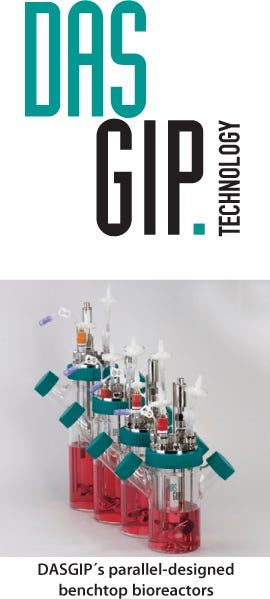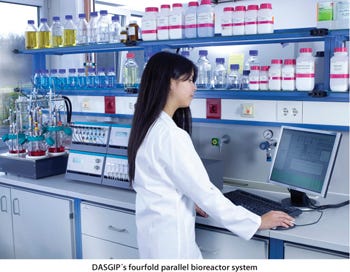Voices of Biotech
Podcast: MilliporeSigma says education vital to creating unbreakable chain for sustainability
MilliporeSigma discusses the importance of people, education, and the benefits of embracing discomfort to bolster sustainability efforts.
July 1, 2009

Equipment automation is the key to the emerging needs of laboratory efficiency. Automation reduces the risk of manual mistakes, minimizes experimental repetitions, and saves material. This retains lower operation costs, increases efficiency, and eases factorial-designed experiment approaches, such as design of experiments (DoE). Automated laboratory processes combined with comprehensive data management programs open the way into laboratory- and site-spanning information networks.
With its Parallel Bioreactor System, DASGIP supports laboratory automation in microbiology and cell culture: It offers excellent opportunities for automation of cultivation processes at small scale including the integration of third-party equipment. Open communication with supervisory control systems, LIMs, and data historians ensures interoperability with existing information networks.
Process Automation Supports PAT
Keeping in mind regulatory demands such as the Process Analytical Technology initiative (PAT) at R&D level can help users shorten time and cost for product approvals by the US FDA.
DASGIP Parallel Bioreactor Systems serve users with adequate tools to maintain the following demands.
Automation Package, Triggering, and Profiles: The DASGIP Automation Package includes a set of easy-to-implement automation features without the need of programming. Possible applications include pH-shift–triggered temperature reduction, a DO-based substrate feed with time-delayed inductor feed, and the automated exchange of culture media linked to defined cell densities.
Michael Thiele, a scientist at ProBioGen AG in Berlin, Germany, uses this package and points out, “We were impressed how easily we could merge MATLAB with the DASGIP Control System to apply our sophisticated Metabolic Flux Model for an online feeding control. Using it within optimized, model-based cell fermentation process control, we were capable of increasing our product yields up to 150% in comparison to our generic feeding strategy.”
Integration of Auto-Samplers and Analyzers: Without adequate software solutions for communication between lab equipment and instruments, lab-automation remains limited and error-prone. “OPC has become the standard for data exchange in the research-driven chemical and pharmaceutical industries,” states Dr. Falk Schneider, executive vice president and director of software engineering at DASGIP AG. “DASGIP is an OPC Foundation member and happy to have entered partnership with key suppliers of laboratory devices to provide state-of-the-art solutions for advanced automation and information management,” he continues.
DASGIP systems can serve as an OPC client to facilitate sophisticated automation of bioprocesses. Using direct OPC communication, DASGIP Parallel Bioreactor Systems allow multivessel autosampling from small-scale bioreactors with sample transfer to multiple analyzers (e.g., Nova Biomedical, Groton Biosystems, Innovatis, and others). This offers real-time monitoring of nutrient concentration, cell viability, or HPLC data, for example. At-line analyzer data is transferred to the DASGIP Control Software, where it is visualized and stored along with all online data. Any OPC data can be used in user-defined functions to allow implementation of real-time nutrient control loops. This supports scientists’ and process engineers’ efforts to implement the PAT initiative along with R&D bioreactors.
Parallel Design Offers Flexibility and supports DoE
DASGIP Parallel Bioreactor System is designed for parallel and controlled cultivation of microorganisms and mammalian cells to promote investigations in biotechnology, pharmaceutical, and chemical research and development.
Parallel Hardware and Software Design: DASGIP Parallel Bioreactor Systems consist of modular components and give users full flexibility to customize their benchtop bioreactor system with vessel sizes ranging from 30 mL to 5 L, the number of parallel operable reactors from 4 to 16, and functionality including monitoring and control of pH, DO, OD, redox, and/or off gas.
Processes using DASGIP systems benefit from high productivity, ease of scalability, and reproducible results. The parallel design of the DASGIP Bioreactor System comes along with a parallel workflow concept for seamless transfer from DoE tools into parallel benchtop bioreactor setups.
Data Mining: The increasing amount of process data generated with parallel bioreactor systems requires an integrated information management. The DASGIP Data Mining Tool ensures that all relevant information related to a cultivation process is collected and compiled. Strain, media, and different recipe information can be stored beginning with process preparation. During the process run, events are logged together with about 50 online process variables and optional integrated analytical data. Such profound knowledge about the descriptive data, the bioreactor setup, and post-process analytics turns raw bioprocess data into valuable process information. Users can, for example, link the strain or cell line used with culture media composition, controller set-points, and feeding profiles (as well as with achieved product yields or viable cell densities) to select for the best optimized combination and process. An included data-mining “wizard” provides an intuitive query interface to select a set of runs that allows data blocking according to customized criteria such as yield or biological system for efficient data reduction.

OPC Server Function Opens Company-Wide Data Access
Using the DASGIP Parallel Bioreactor System, all process data including events, setup information, and system status is logged into a central SQL database during an experiment. The DASGIP Data Management System not only ensures comparability of process data generated in successive runs or within one project, but also allows analysis of historical data stored in the database at any time.
To fulfill the needs of globally operating companies, the new DASGIP software Control 4.0 OPC Edition can expose online process variables of an OPC server. This ensures a unified information exchange with third-party applications such as supervisory control systems, LIMS, and data historians. Aligning runtime data from process development along with batch data from pilot scale or even production now becomes a reality.
Conclusion
DASGIP technology is designed for advanced applications combining hardware precision with software flexibility. Various setups and options support different degrees of process automation and allow users to accelerate their process development. The truly parallel and modular design of DASGIP systems combined with comprehensive data management support users to develop, optimize, and automate their processes with an unparalleled efficiency.
You May Also Like